Gilles Callebaut
Testbed Evaluation of AI-based Precoding in Distributed MIMO Systems
Nov 14, 2025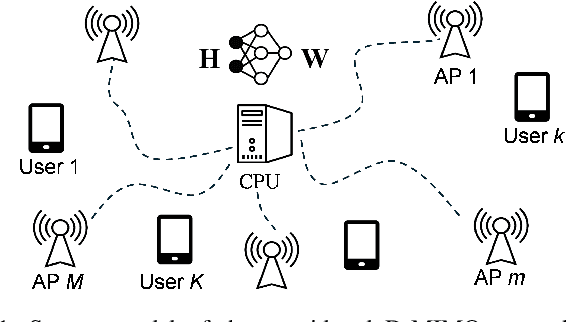
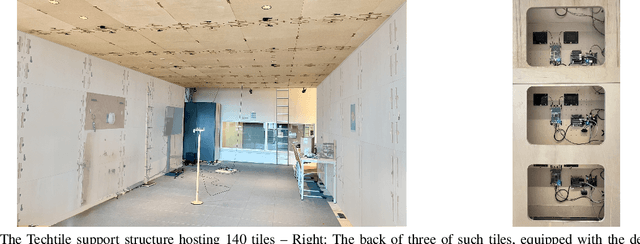
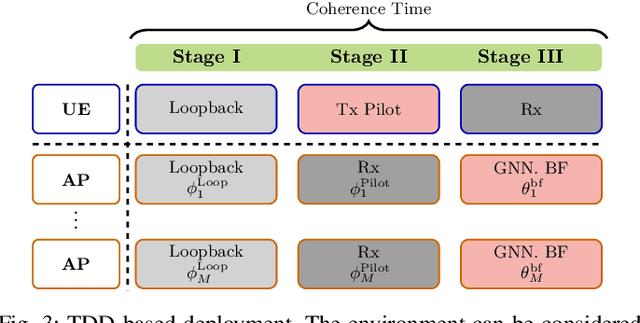
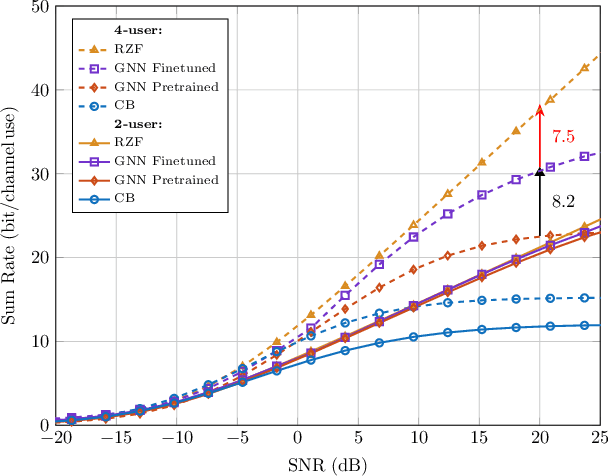
Abstract:Distributed MIMO (D-MIMO) has emerged as a key architecture for future sixth-generation (6G) networks, enabling cooperative transmission across spatially distributed access points (APs). However, most existing studies rely on idealized channel models and lack hardware validation, leaving a gap between algorithmic design and practical deployment. Meanwhile, recent advances in artificial intelligence (AI)-driven precoding have shown strong potential for learning nonlinear channel-to-precoder mappings, but their real-world deployment remains limited due to challenges in data collection and model generalization. This work presents a framework for implementing and validating an AI-based precoder on a D-MIMO testbed with hardware reciprocity calibration. A pre-trained graph neural network (GNN)-based model is fine-tuned using real-world channel state information (CSI) collected from the Techtile platform and evaluated under both interpolation and extrapolation scenarios before end-to-end validation. Experimental results demonstrate a 15.7% performance gain over the pre-trained model in the multi-user case after fine-tuning, while in the single-user scenario the model achieves near-maximum ratio transmission (MRT) performance with less than 0.7 bits/channel use degradation out of a total throughput of 5.19 bits/channel use on unseen positions. Further analysis confirms the data efficiency of real-world measurements, showing consistent gains with increasing training samples, and end-to-end validation verifies coherent power focusing comparable to MRT.
RF-Powered Batteryless Plant Movement Sensor for Precision Agriculture
Sep 16, 2025Abstract:Precision agriculture demands non-invasive, energy-efficient, and sustainable plant monitoring solutions. In this work, we present the design and implementation of a lightweight, batteryless plant movement sensor powered solely by RF energy. This sensor targets Controlled Environment Agriculture (CEA) and utilizes inertial measurements units (IMUs) to monitor leaf motion, which correlates with plant physiological responses to environmental stress. By eliminating the battery, we reduce the ecological footprint, weight, and maintenance requirements, transitioning from lifetime-based to operation-based energy storage. Our design minimizes circuit complexity while enabling flexible, adaptive readout scheduling based on energy availability and sensor data. We detail the energy requirements, RF power transfer considerations, integration constraints, and outline future directions, including multi-antenna power delivery and networked sensor synchronization.
A Low-Cost Open-Source BLE-Based Asian Hornet Tracking System
Sep 04, 2025Abstract:The Asian hornet (Vespa velutina) poses a serious threat to ecosystems and beekeeping. Locating nests is essential, but usually involves time-consuming manual triangulation. We present a low-cost, open-source tracking system based on Bluetooth Low Energy (BLE). The system consists of a lightweight BLE tag and a software-defined radio (SDR) receiver implemented in GNU Radio. By bypassing the BLE stack, we embed a custom pseudo-noise (PN) sequence in the uncoded PHY for correlation-based detection. Using a Yagi antenna and PlutoSDR, the receiver performs digital beam sweeping to determine the tag's direction. Field tests show reliable angular resolution at 50m and a communication range up to 360m. While our modulation increases receiver complexity, it enables future improvements such as multichannel spreading and tag identification. The design is fully open-source and provides a scalable framework for hornet tracking and related applications in environmental monitoring.
GNN-based Precoder Design and Fine-tuning for Cell-free Massive MIMO with Real-world CSI
May 13, 2025Abstract:Cell-free massive MIMO (CF-mMIMO) has emerged as a promising paradigm for delivering uniformly high-quality coverage in future wireless networks. To address the inherent challenges of precoding in such distributed systems, recent studies have explored the use of graph neural network (GNN)-based methods, using their powerful representation capabilities. However, these approaches have predominantly been trained and validated on synthetic datasets, leaving their generalizability to real-world propagation environments largely unverified. In this work, we initially pre-train the GNN using simulated channel state information (CSI) data, which incorporates standard propagation models and small-scale Rayleigh fading. Subsequently, we finetune the model on real-world CSI measurements collected from a physical testbed equipped with distributed access points (APs). To balance the retention of pre-trained features with adaptation to real-world conditions, we adopt a layer-freezing strategy during fine-tuning, wherein several GNN layers are frozen and only the later layers remain trainable. Numerical results demonstrate that the fine-tuned GNN significantly outperforms the pre-trained model, achieving an approximate 8.2 bits per channel use gain at 20 dB signal-to-noise ratio (SNR), corresponding to a 15.7 % improvement. These findings highlight the critical role of transfer learning and underscore the potential of GNN-based precoding techniques to effectively generalize from synthetic to real-world wireless environments.
Physically Large Apertures for Wireless Power Transfer: Performance and Regulatory Aspects
Mar 09, 2025Abstract:Wireless power transfer (WPT) is a promising service for the Internet of Things, providing a cost-effective and sustainable solution to deploy so-called energy-neutral devices on a massive scale. The power received at the device side decays rapidly with the distance from a conventional transmit antenna with a physically small aperture. New opportunities arise from the transition from conventional far-field beamforming to near-field beam focusing. We argue that a "physically large" aperture, i.e., large w.r.t. the distance to the receiver, enables a power budget that remains practically independent of distance. Distance-dependent array gain patterns allow focusing the power density maximum precisely at the device location, while reducing the power density near the infrastructure. The physical aperture size is a key resource in enabling efficient yet regulatory-compliant WPT. We use real-world measurements to demonstrate that a regulatory-compliant system operating at sub-10GHz frequencies can increase the power received at the device into the milliwatt range. Our empirical demonstration shows that power-optimal near-field beam focusing inherently exploits multipath propagation, yielding both increased WPT efficiency and improved human exposure safety in real-world scenarios.
Experimental Study on the Effect of Synchronization Accuracy for Near-Field RF Wireless Power Transfer in Multi-Antenna Systems
Dec 15, 2024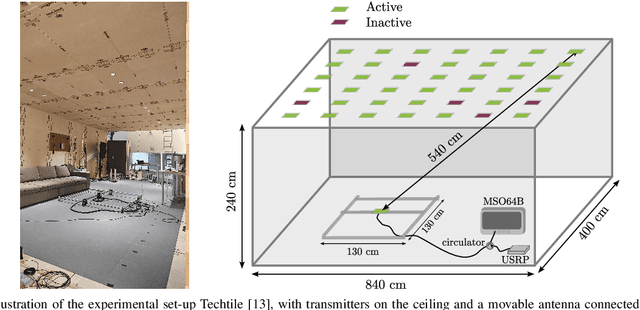
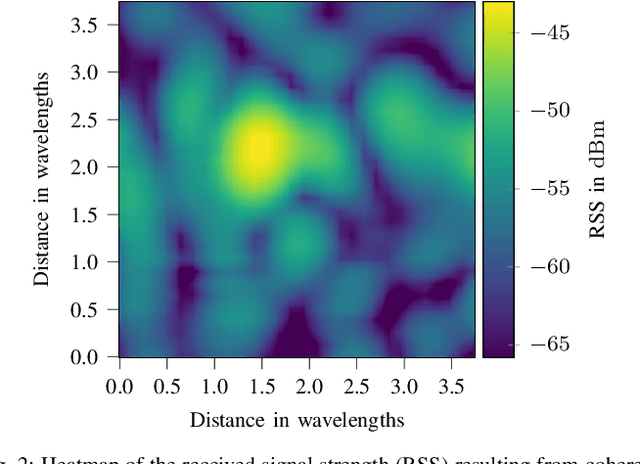
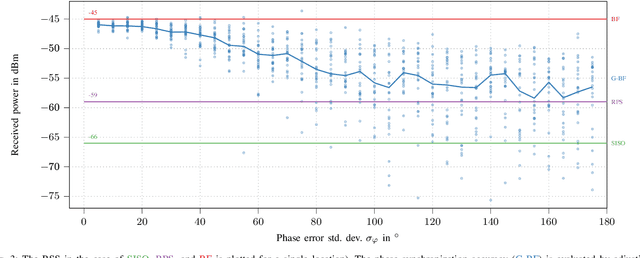

Abstract:Wireless power transfer (WPT) technologies hold promise for enhancing device autonomy, particularly for energy-limited IoT systems. This paper presents experimental results on coherent and non-coherent transmit diversity approaches for WPT, tested in the near field using the Techtile testbed. We demonstrate that a fully synchronized beamfocusing system achieves a 14 dB gain over non-coherent transmission, consistent with the theoretical 14.9 dB gain for a 31-element array. Additionally, phase alignment errors below 20{\deg} result in less than 1 dB of gain loss, while errors exceeding 40{\deg} lead to losses over 3 dB. These findings suggest that phase coherency requirements for WPT can be relaxed, and that scaling the number of antennas is a promising strategy for improving power transfer efficiency.
How to Perform Distributed Precoding to Wirelessly Power Shelf Labels: Signal Processing and Measurements
Aug 20, 2024Abstract:Wireless power transfer (WPT) has garnered increasing attention due to its potential to eliminate device-side batteries. With the advent of (distributed) multiple-input multiple-output (MIMO), radio frequency (RF) WPT has become feasible over extended distances. This study focuses on optimizing the energy delivery to Energy Receivers (ERs) while minimizing system total transmit power. Rather than continuous power delivery, we optimize the precoding weights within specified time slots to meet the energy requirements of the ERs. Both unsynchronized (non-coherent) and synchronized (coherent) systems are evaluated. Our analysis indicates that augmenting the number of antennas and transitioning from an unsynchronized to asynchronized full phase-coherent system substantially enhances system performance. This optimization ensures precise energy delivery, reducing overshoots and overall energy consumption. Experimental validation was conducted using a testbed with84 antennas, validating the trends observed in our numerical simulations.
MmWave for Extended Reality: Open User Mobility Dataset, Characterisation, and Impact on Link Quality
Jul 02, 2024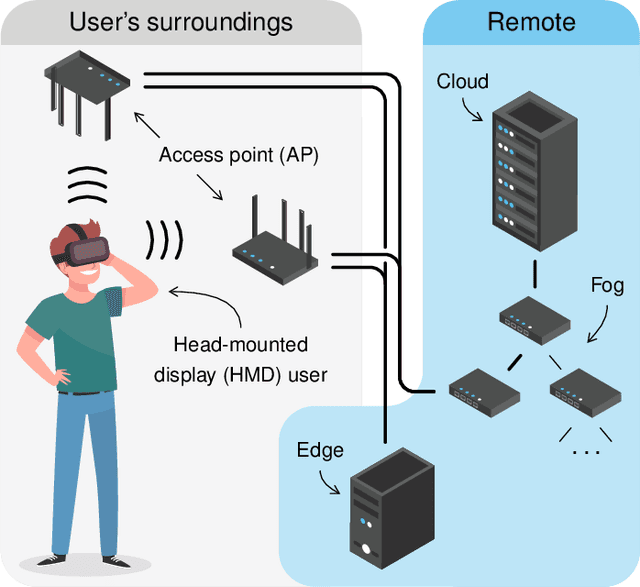
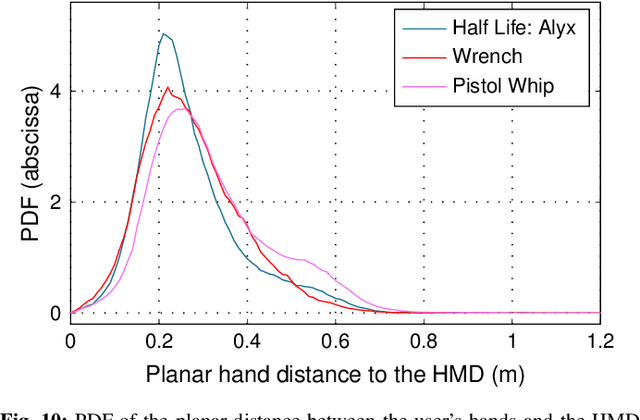
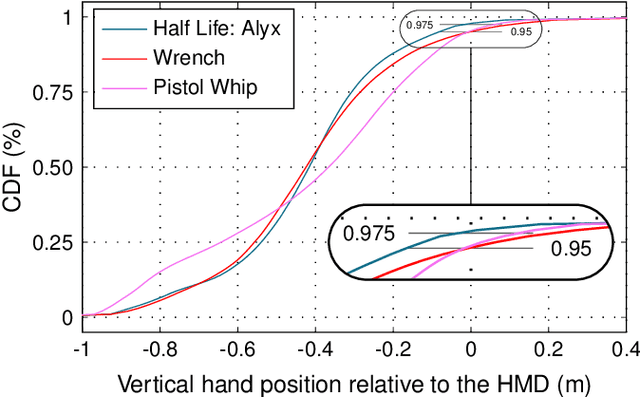
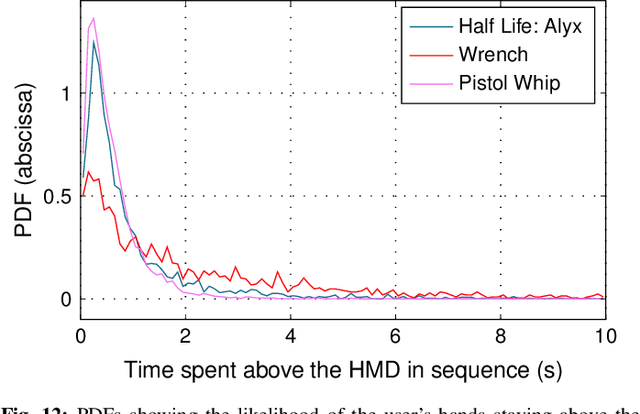
Abstract:User mobility in extended reality (XR) can have a major impact on millimeter-wave (mmWave) links and may require dedicated mitigation strategies to ensure reliable connections and avoid outage. The available prior art has predominantly focused on XR applications with constrained user mobility and limited impact on mmWave channels. We have performed dedicated experiments to extend the characterisation of relevant future XR use cases featuring a high degree of user mobility. To this end, we have carried out a tailor-made measurement campaign and conducted a characterisation of the collected tracking data, including the approximation of the data using statistical distributions. Moreover, we have provided an interpretation of the possible impact of the recorded mobility on mmWave technology. The dataset is made publicly accessible to provide a testing ground for wireless system design and to enable further XR mobility modelling.
IoT on the Road to Sustainability: Vehicle or Bandit?
May 31, 2024Abstract:The Internet of Things (IoT) can support the evolution towards a digital and green future. However, the introduction of the technology clearly has in itself a direct adverse ecological impact. This paper assesses this impact at both the IoT-node and at the network side. For the nodes, we show that the electronics production of devices comes with a carbon footprint that can be much higher than during operation phase. We highlight that the inclusion of IoT support in existing cellular networks comes with a significant ecological penalty, raising overall energy consumption by more than 15%. These results call for novel design approaches for the nodes and for early consideration of the support for IoT in future networks. Raising the 'Vehicle or bandit?' question on the nature of IoT in the broader sense of sustainability, we illustrate the need for multidisciplinary cooperation to steer applications in desirable directions.
Energy Reduction in Cell-Free Massive MIMO through Fine-Grained Resource Management
May 11, 2024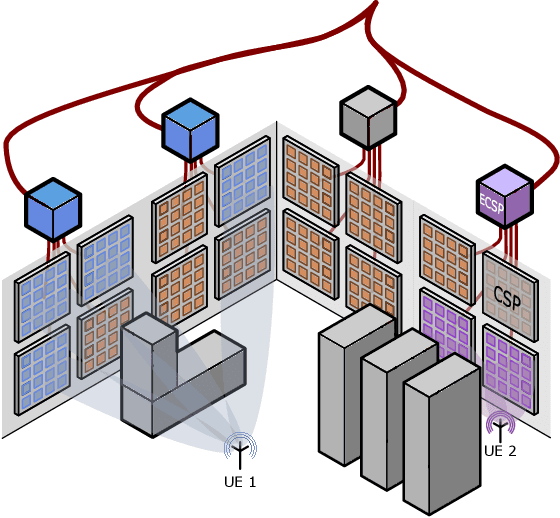
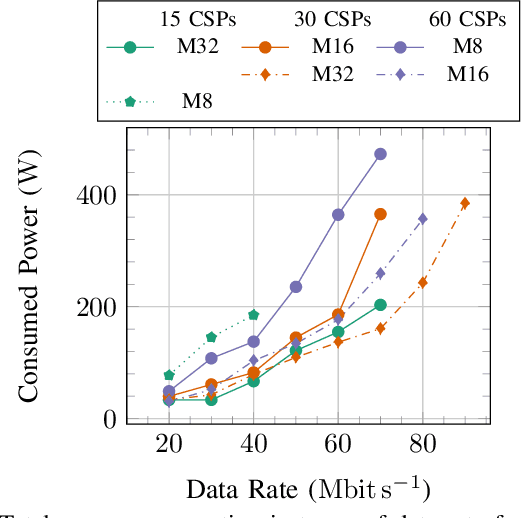
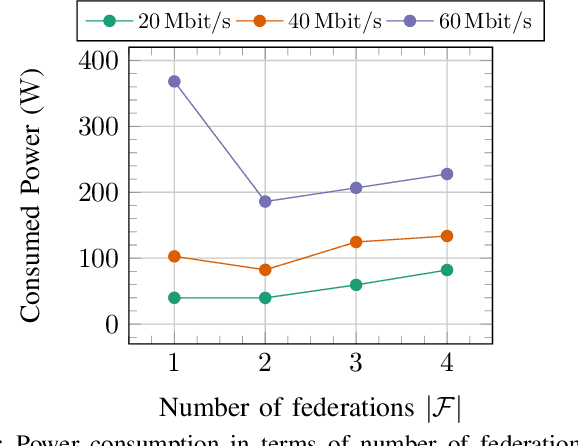
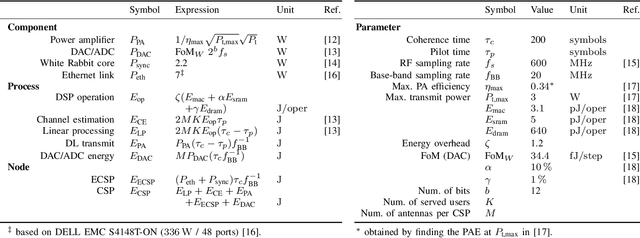
Abstract:The physical layer foundations of cell-free massive MIMO (CF-mMIMO) have been well-established. As a next step, researchers are investigating practical and energy-efficient network implementations. This paper focuses on multiple sets of access points (APs) where user equipments (UEs) are served in each set, termed a federation, without inter-federation interference. The combination of federations and CF-mMIMO shows promise for highly-loaded scenarios. Our aim is to minimize the total energy consumption while adhering to UE downlink data rate constraints. The energy expenditure of the full system is modelled using a detailed hardware model of the APs. We jointly design the AP-UE association variables, determine active APs, and assign APs and UEs to federations. To solve this highly combinatorial problem, we develop a novel alternating optimization algorithm. Simulation results for an indoor factory demonstrate the advantages of considering multiple federations, particularly when facing large data rate requirements. Furthermore, we show that adopting a more distributed CF-mMIMO architecture is necessary to meet the data rate requirements. Conversely, if feasible, using a less distributed system with more antennas at each AP is more advantageous from an energy savings perspective.
 Add to Chrome
Add to Chrome Add to Firefox
Add to Firefox Add to Edge
Add to Edge